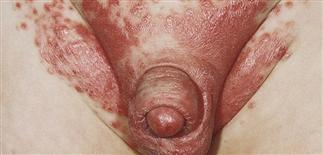69
Candidiasis
(diaper dermatitis)

Trapped moisture from urine and feces as well as alkaline pH break the skin barrier.

Compromised skin barrier is colonized by yeast present in stool.

Fragile pustules break, leaving shallow erosions.

An artificial intertriginous area is created under a wet diaper, predisposing the area to a yeast infection with the characteristic red base and satellite pustules.
DESCRIPTION
Diaper dermatitis is a term that encompasses a number of skin conditions causing red, scaly rashes in the diaper area.
HISTORY
• Diapers occlude the skin, leading to skin maceration and predisposing to skin infection and inflammation. Frequent diaper changes decrease incidence of diaper dermatitis. Absorbent disposable diapers effectively draw moisture away from the skin. • Elevations in skin pH occur under occlusive conditions when skin is in prolonged contact with urine and stool, especially with diarrheal illness. Skin breakdown results.
PHYSICAL FINDINGS
• Several causes of inflammation in the diaper area. Irritant contact dermatitis is the most common diaper area rash, with red, scaly, eroded, painful plaques on convex surfaces and sparing of creases. Seborrheic dermatitis affects the scalp and intertriginous areas, including diaper area. Red, scaly plaques occur on scrotum, penis, labia majora, pubis, inguinal and gluteal folds. Psoriasis can be isolated to the diaper area and appears identical to seborrheic dermatitis. • Candidiasis is an acute infection of the superficial layers of the skin. Can be either a primary cause of diaper dermatitis, occurring as bright-red (beefy-red) plaques in inguinal and gluteal folds, or secondary, occurring in setting of seborrheic dermatitis or psoriasis. • Satellite pustules are hallmark of Candida dermatitis. Pustules rupture to form a superficial collarette of scale. Chronic, poorly treated Candida diaper dermatitis can form granulomatous nodules. • Potassium hydroxide examination confirms presence of pseudohyphae and spores if present. Culture results are often mixed with bacterial superinfection as well as Candida species.
TREATMENT
• Therapy should be directed at minimizing wetness in diaper area, with frequent diaper changes and brief diaper-free periods. Barrier ointments such as petrolatum, Aquaphor ointment, or 40% zinc oxide ointment are useful for prophylaxis. Avoid cleaning with irritating baby wipes. Apply 1% hydrocortisone cream twice daily until inflammation controlled. Pimecrolimus (Elidel) 1% cream and tacrolimus (Protopic) 0.03% ointment are steroid-free anti-inflammatory alternatives. • Treat Candida infection with miconazole, clotrimazole, ketoconazole, oxiconazole, or Spectazole cream applied twice daily for a week or two. Do not apply at the same time as the anti-inflammatory therapy; consider alternating applications with successive diaper changes. • Recommend Pampers Rash Guard diapers (Procter & Gamble), which reduce severity and frequency of diaper rash by delivering petrolatum to diaper area.







